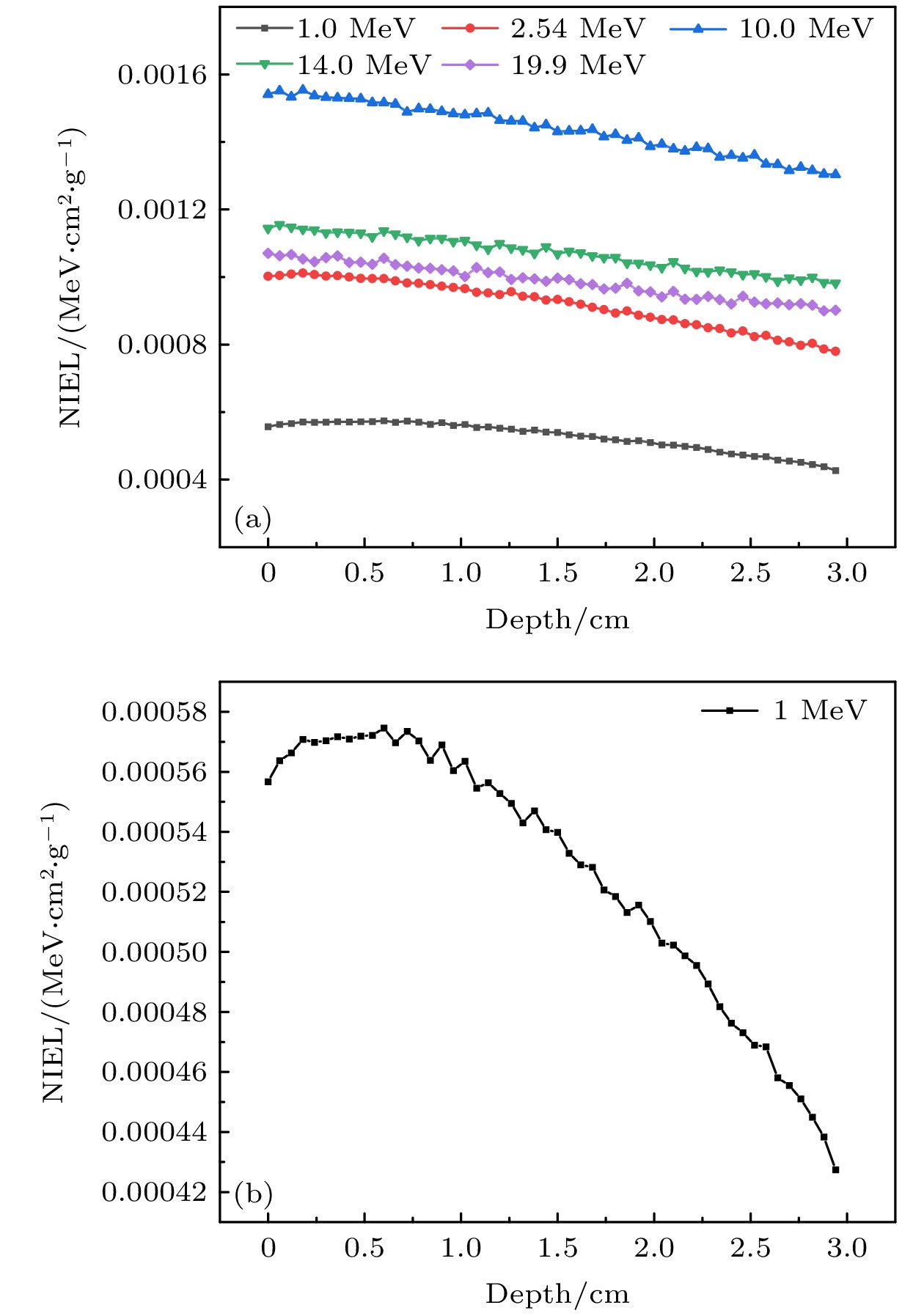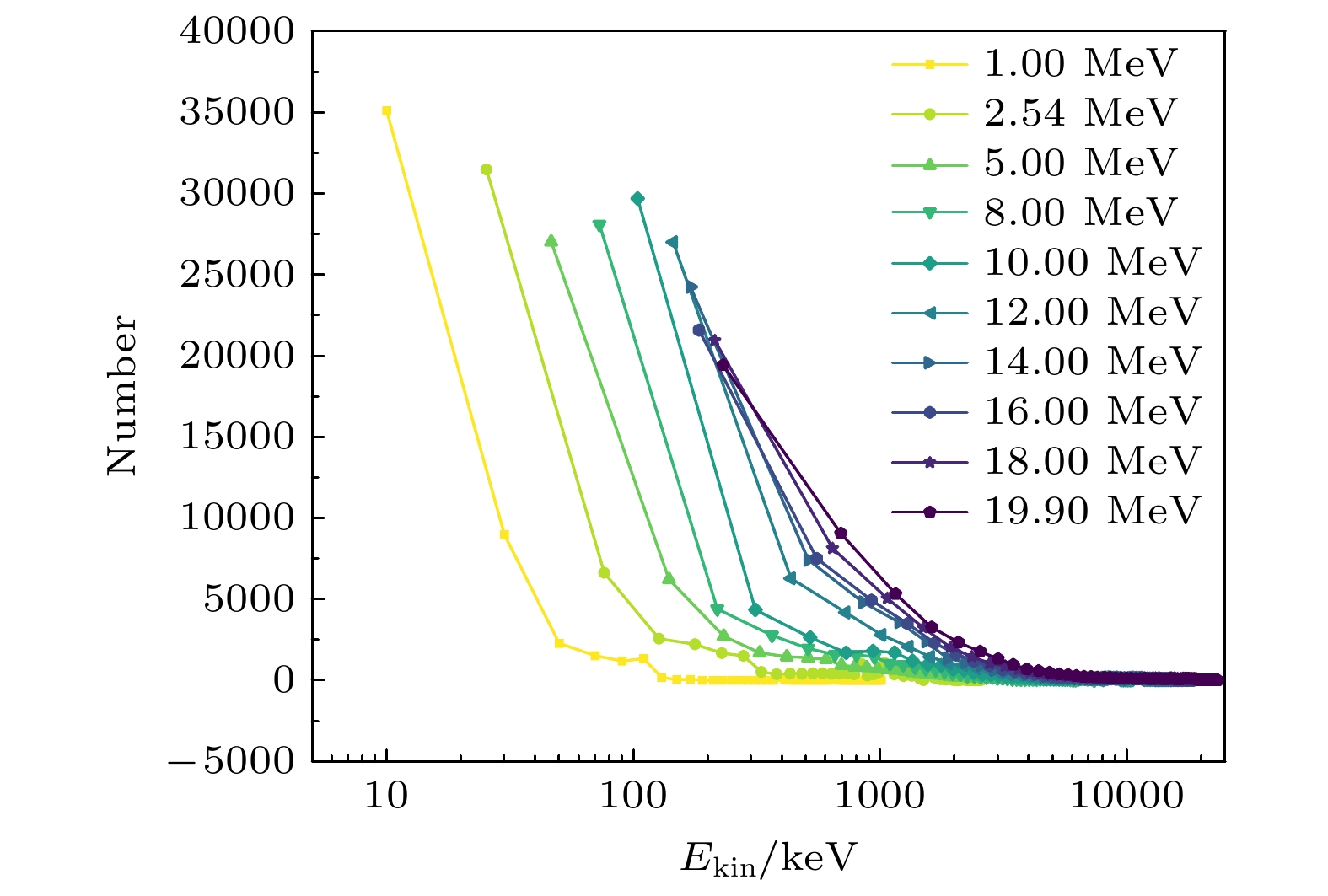-
磷化铟(InP)作为第二代化合物半导体材料, 抗辐照能力强, 光电转换效率高, 在光子领域和射频领域具有优势. 大气空间中, InP半导体器件受大气中子辐照影响, 器件性能发生退化. 本文采用蒙特卡罗模拟软件Geant4对InP中子辐照效应进行模拟, 得到InP中不同能量中子产生的位移损伤初态分布. 结果表明: 在微米量级内, 非电离能量损失(NIEL)随深度均匀分布, 在厘米及更高量级上, NIEL随着入射深度的增大而降低, 当靶材料足够厚时可以降低至零; 分析1—20 MeV中子入射3 μm InP产生的NIEL及其随深度分布, 发现NIEL随入射中子能量的增加呈现出先升后降的趋势, 该趋势主要由非弹性散射反应产生的初级反冲原子(PKA)造成; 分析1—20 MeV中子入射3 μm InP产生的PKA种类、能量, 发现In/P的PKA占比较大, 是产生位移损伤的主要因素, 中子能量越高, PKA的种类越丰富, PKA最大动能越大, 但PKA主要分布在低能部分. 研究结果对InP基5G器件在大气中子辐射环境中的长期应用具有理论和指导价值.As the second-generation compound semiconductor material, indium phosphide (InP) has strong irradiation resistance and high photoelectric conversion efficiency. It has advantages in the field of photonics and radio frequency. In atmospheric space, high-energy cosmic rays enter into the earth’s atmosphere and interact with nitrogen (N), oxygen (O) and other elements to produce secondary cosmic rays. The irradiation particles in the atmosphere are mainly neutrons because the penetration of charged particles is weak. The InP semiconductor devices are affected by atmospheric neutron irradiation of various energy from all directions, which results in the internal defects in InP crystals, the degradation of device performance and the reduction of device lifetime. In this paper, Monte Carlo simulation software Geant4 is used to simulate the neutron irradiation effect, and the initial state distribution of displacement damage caused by neutrons with different energy is obtained, including the distribution of non-ionized energy loss (NIEL) with depth, the relationship between NIEL and the energy of incident neutrons, and the type, number and energy of primary knock-on atoms (PKA). The results show that 1) the NIEL is uniformly distributed when material thickness is on the order of μm and for the material thickness on the order of cm and more, the NIEL decreases as the depth increases and can be reduced to zero when the target material is thick enough; 2) by analyzing the NIEL produced by 1–20 MeV neutrons incident on 3-μm InP and their distribution with depth, it is found that the NIEL first increases and then decreases with incident neutron energy increasing. This trend is caused mainly by PKA produced through the inelastic scattering reaction; 3) by analyzing the type and the energy of PKA produced by 1–20 MeV neutrons incident on 3 μm InP, it is found that the PKA of In/P accounts for a large proportion, which causes displacement damage mainly, and the higher the neutron energy, the richer the variety of PKA is and the greater the maximum kinetic energy of PKA, but the PKAs mainly distribute in the low energy part. The present research has theoretical and guiding value for the long-term application of InP-based 5G devices in atmospheric neutron irradiation environment.
-
Keywords:
- neutron /
- InP /
- displacement damage /
- non-ionized energy loss
[1] O'Neill P M 2010 IEEE Trans. Nucl. Sci. 57 3148
[2] 陈启明, 郭刚, 祁琳, 张付强 2018 科技创新导报 15 127
 Google Scholar
Google Scholar
Chen Q M, Guo G, Qi L, Zhang F Q 2018 Sci. Technol. Innov. Her. 15 127
 Google Scholar
Google Scholar
[3] Jay A, Raine M, Richard N, Mousseau N, Goiffon V, Hémeryck A, Magnan P 2017 IEEE Trans. Nucl. Sci. 64 141
 Google Scholar
Google Scholar
[4] Atmospheric Radiation Effects Whitepaper, Vranish K http://www.kva-engineering.com/pdf/SEU_whitepaper_FAA_Con.pdf [2021-9-8]
[5] Inguimbert C, Gigante R 2006 IEEE Trans. Nucl. Sci. 53 1967
 Google Scholar
Google Scholar
[6] Messenger S R 1999 IEEE Trans. Nucl. Sci. 46 1595
 Google Scholar
Google Scholar
[7] Autran J, Munteanu D 2020 IEEE Trans. Nucl. Sci. 67 1428
 Google Scholar
Google Scholar
[8] Ruzin A, Casse G, Glaser M, Zanet A, Lemeilleur F, Watts S 1999 IEEE Trans. Nucl. Sci. 46 1310
 Google Scholar
Google Scholar
[9] Messenger S R, Burke E A, Lorentzen J, Walters R J, Warner J H, Summers G P, Murray S L, Murray C S, Crowley C J, Elkouh N A 2005 Conference Record of the Thirty-first IEEE Photovoltaic Specialists Conference FL, USA, Jan 3–7, 2005 p559
[10] Tonigan A M, Arutt C N, Parma E J, Griffin P J, Fleetwood D M, Schrimpf R D 2018 IEEE Trans. Nucl. Sci. 65 495
 Google Scholar
Google Scholar
[11] Jiang W, Yue C, Cui M Y, et al. 2020 Chin. Phys. Lett. 37 119601
 Google Scholar
Google Scholar
[12] Agostinelli S, Allison J, Amako K, Apostolakis J, Zschiesche D 2003 Nucl. Instrum. Methods Phys. Res., Sect. A 506 250
 Google Scholar
Google Scholar
[13] 白雨蓉, 李永宏, 刘方, 廖文龙, 何欢, 杨卫涛, 贺朝会 2021 70 172401
 Google Scholar
Google Scholar
Bai Y R, Li Y H, Liu F, Liao W L, He H, Yang W T, He C H 2021 Acta Phys. Sin. 70 172401
 Google Scholar
Google Scholar
[14] 郭达禧, 贺朝会, 臧航, 席建琦, 马梨, 杨涛, 张鹏 2013 原子能科学技术 47 1222
 Google Scholar
Google Scholar
Guo D X, He C H, Zang H, Xi J Q, Ma L, Yang T, Zhang P 2013 Atom. Energ. Sci. Technol. 47 1222
 Google Scholar
Google Scholar
[15] 谢飞, 臧航, 刘方, 何欢, 廖文龙, 黄煜 2020 69 126
Xie F, Zang H, Liu F, He H, Liao W L, Huang Y 2020 Acta Phys. Sin. 69 126
[16] 朱金辉, 韦源, 谢红刚, 牛胜利, 黄流兴 2014 63 066102
 Google Scholar
Google Scholar
Zhu J H, Wei Y, Xie H G, Niu S L, Huang L X 2014 Acta Phys. Sin. 63 066102
 Google Scholar
Google Scholar
[17] 唐欣欣, 罗文芸, 王朝壮, 贺新福, 查元梓, 樊胜, 黄小龙, 王传珊 2008 57 1266
 Google Scholar
Google Scholar
Tang X X, Luo W H, Wang C Z, He F X, Zha Y Z, Fan S, Huang X L, Wang C S 2008 Acta Phys. Sin. 57 1266
 Google Scholar
Google Scholar
[18] 吴宜勇, 岳龙, 胡建民, 蓝慕杰, 肖景东, 杨德庄, 何世禹, 张忠卫, 王训春, 钱勇, 陈鸣波 2011 60 098110
 Google Scholar
Google Scholar
Wu Y Y, Yue L, Hu J M, Lan M J, Xiao J D, Yang D Z, He S Y, Zhang Z W, Wang X C, Qian Y, Chen M B 2011 Acta Phys. Sin. 60 098110
 Google Scholar
Google Scholar
[19] 张利英, 倪伟俊, 敬罕涛, 王相綦 2018 现代应用物理 9 10
Zhang L Y, Ni W J, Jing H T, Wang X Q 2018 Mod. Appl. Phys. 9 10
[20] Robinson M T, Torrens I M 1974 Phys. Rev. B 9 5008
 Google Scholar
Google Scholar
[21] Akkerman A, Barak J 2007 Nucl. Instrum. Methods Phys. Res. Sect. B 260 529
 Google Scholar
Google Scholar
[22] Shatalov A, Subramanian S, Klein A 2001 IEEE Trans. Nucl. Sci. 48 2262
 Google Scholar
Google Scholar
[23] Walters R J, Messenger S R, Cotal H L, Xapsos M A, Summers G P 1997 J. Appl. Phys. 82 2164
 Google Scholar
Google Scholar
[24] 杨福家, 王炎森, 陆福全 1993 原子核物理 (上海: 复旦大学出版社) 第195页
Yang F J, Wang Y S, Lu F Q 1993 Nuclear Physics (Shanghai: Fudan University Press) p195 (in Chinese)
-
表 1 1—20 MeV中子入射3 μm的InP薄靶所得PKA的种类、数目与动能信息
Table 1. The type, number, and energy information of PKA obtained from 3 μm InP thin target irradiated by 1—20 MeV neutrons.
入射中子能量/MeV 反冲核(PKA)种类 最小动能/eV 最大动能/keV 元素占比/% 1.00 113—116In 1.11 35.01 70.51 31—32P 2.48 122.37 29.49 2.54 113—116In 1.41 89.03 62.08 31—32P 14.74 310.69 36.57 1H, 31Si 1.57 263.36 1.36 5.00 113, 115, 116In 2.33 173.05 59.21 31—32P 6.10 612.41 37.57 1H, 31Si, 4He, 28Al, 2.21 4283.90 3.22 8.00 113, 115In 1.57 281.82 64.42 31P 17.12 980.54 28.80 1H, 31Si, 4He, 28Al, 113, 115Cd 1.00 7282.10 6.78 10.00 113, 115In 1.29 350.53 66.42 31P 1.00 1225.70 25.58 1H, 31Si, 4He, 28Al, 115Cd, 112Ag 1.00 9287.10 8.00 12.00 113, 115In 1.11 417.21 63.21 31P 1.00 1473.49 27.51 1H, 31Si, 4He, 28Al, 113, 115Cd, 112Ag 1.00 14315.00 9.29 14.00 113, 115In 1.04 492.34 60.26 31P 1.00 1705.77 29.71 1—2H, 31Si, 4He, 28Al, 112—115Cd, 110, 112Ag 1.00 16463.00 10.03 16.00 113, 115In 1.12 556.47 57.82 31P 1.00 1967.15 31.98 1—2H, 31Si, 4He, 28Al, 113—115Cd, 110, 112Ag 1.00 17593.00 10.20 18.00 113, 115In 1.45 631.07 54.70 31P 1.00 2215.82 34.42 1—3H, 31Si, 4He, 28Al, 111—115Cd, 110, 112Ag 1.00 21054.00 10.88 19.90 113, 115In 2.04 703.43 50.34 31P 1.00 2453.43 37.58 1—3H, 31Si, 4He, 28Al, 111—115Cd, 110, 112Ag 1.00 22391.00 12.08 -
[1] O'Neill P M 2010 IEEE Trans. Nucl. Sci. 57 3148
[2] 陈启明, 郭刚, 祁琳, 张付强 2018 科技创新导报 15 127
 Google Scholar
Google Scholar
Chen Q M, Guo G, Qi L, Zhang F Q 2018 Sci. Technol. Innov. Her. 15 127
 Google Scholar
Google Scholar
[3] Jay A, Raine M, Richard N, Mousseau N, Goiffon V, Hémeryck A, Magnan P 2017 IEEE Trans. Nucl. Sci. 64 141
 Google Scholar
Google Scholar
[4] Atmospheric Radiation Effects Whitepaper, Vranish K http://www.kva-engineering.com/pdf/SEU_whitepaper_FAA_Con.pdf [2021-9-8]
[5] Inguimbert C, Gigante R 2006 IEEE Trans. Nucl. Sci. 53 1967
 Google Scholar
Google Scholar
[6] Messenger S R 1999 IEEE Trans. Nucl. Sci. 46 1595
 Google Scholar
Google Scholar
[7] Autran J, Munteanu D 2020 IEEE Trans. Nucl. Sci. 67 1428
 Google Scholar
Google Scholar
[8] Ruzin A, Casse G, Glaser M, Zanet A, Lemeilleur F, Watts S 1999 IEEE Trans. Nucl. Sci. 46 1310
 Google Scholar
Google Scholar
[9] Messenger S R, Burke E A, Lorentzen J, Walters R J, Warner J H, Summers G P, Murray S L, Murray C S, Crowley C J, Elkouh N A 2005 Conference Record of the Thirty-first IEEE Photovoltaic Specialists Conference FL, USA, Jan 3–7, 2005 p559
[10] Tonigan A M, Arutt C N, Parma E J, Griffin P J, Fleetwood D M, Schrimpf R D 2018 IEEE Trans. Nucl. Sci. 65 495
 Google Scholar
Google Scholar
[11] Jiang W, Yue C, Cui M Y, et al. 2020 Chin. Phys. Lett. 37 119601
 Google Scholar
Google Scholar
[12] Agostinelli S, Allison J, Amako K, Apostolakis J, Zschiesche D 2003 Nucl. Instrum. Methods Phys. Res., Sect. A 506 250
 Google Scholar
Google Scholar
[13] 白雨蓉, 李永宏, 刘方, 廖文龙, 何欢, 杨卫涛, 贺朝会 2021 70 172401
 Google Scholar
Google Scholar
Bai Y R, Li Y H, Liu F, Liao W L, He H, Yang W T, He C H 2021 Acta Phys. Sin. 70 172401
 Google Scholar
Google Scholar
[14] 郭达禧, 贺朝会, 臧航, 席建琦, 马梨, 杨涛, 张鹏 2013 原子能科学技术 47 1222
 Google Scholar
Google Scholar
Guo D X, He C H, Zang H, Xi J Q, Ma L, Yang T, Zhang P 2013 Atom. Energ. Sci. Technol. 47 1222
 Google Scholar
Google Scholar
[15] 谢飞, 臧航, 刘方, 何欢, 廖文龙, 黄煜 2020 69 126
Xie F, Zang H, Liu F, He H, Liao W L, Huang Y 2020 Acta Phys. Sin. 69 126
[16] 朱金辉, 韦源, 谢红刚, 牛胜利, 黄流兴 2014 63 066102
 Google Scholar
Google Scholar
Zhu J H, Wei Y, Xie H G, Niu S L, Huang L X 2014 Acta Phys. Sin. 63 066102
 Google Scholar
Google Scholar
[17] 唐欣欣, 罗文芸, 王朝壮, 贺新福, 查元梓, 樊胜, 黄小龙, 王传珊 2008 57 1266
 Google Scholar
Google Scholar
Tang X X, Luo W H, Wang C Z, He F X, Zha Y Z, Fan S, Huang X L, Wang C S 2008 Acta Phys. Sin. 57 1266
 Google Scholar
Google Scholar
[18] 吴宜勇, 岳龙, 胡建民, 蓝慕杰, 肖景东, 杨德庄, 何世禹, 张忠卫, 王训春, 钱勇, 陈鸣波 2011 60 098110
 Google Scholar
Google Scholar
Wu Y Y, Yue L, Hu J M, Lan M J, Xiao J D, Yang D Z, He S Y, Zhang Z W, Wang X C, Qian Y, Chen M B 2011 Acta Phys. Sin. 60 098110
 Google Scholar
Google Scholar
[19] 张利英, 倪伟俊, 敬罕涛, 王相綦 2018 现代应用物理 9 10
Zhang L Y, Ni W J, Jing H T, Wang X Q 2018 Mod. Appl. Phys. 9 10
[20] Robinson M T, Torrens I M 1974 Phys. Rev. B 9 5008
 Google Scholar
Google Scholar
[21] Akkerman A, Barak J 2007 Nucl. Instrum. Methods Phys. Res. Sect. B 260 529
 Google Scholar
Google Scholar
[22] Shatalov A, Subramanian S, Klein A 2001 IEEE Trans. Nucl. Sci. 48 2262
 Google Scholar
Google Scholar
[23] Walters R J, Messenger S R, Cotal H L, Xapsos M A, Summers G P 1997 J. Appl. Phys. 82 2164
 Google Scholar
Google Scholar
[24] 杨福家, 王炎森, 陆福全 1993 原子核物理 (上海: 复旦大学出版社) 第195页
Yang F J, Wang Y S, Lu F Q 1993 Nuclear Physics (Shanghai: Fudan University Press) p195 (in Chinese)
计量
- 文章访问数: 10793
- PDF下载量: 281
- 被引次数: 0














 下载:
下载:







